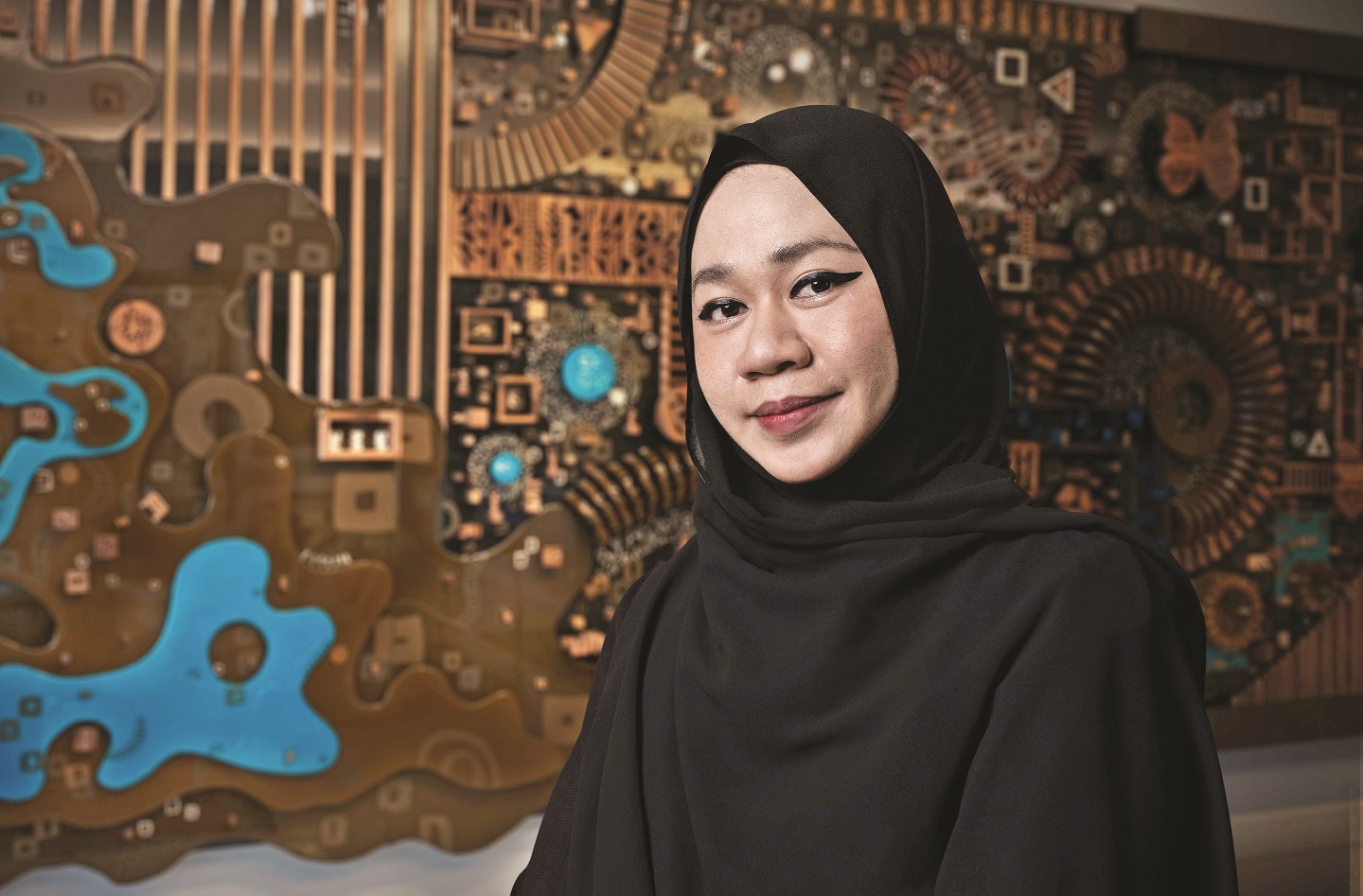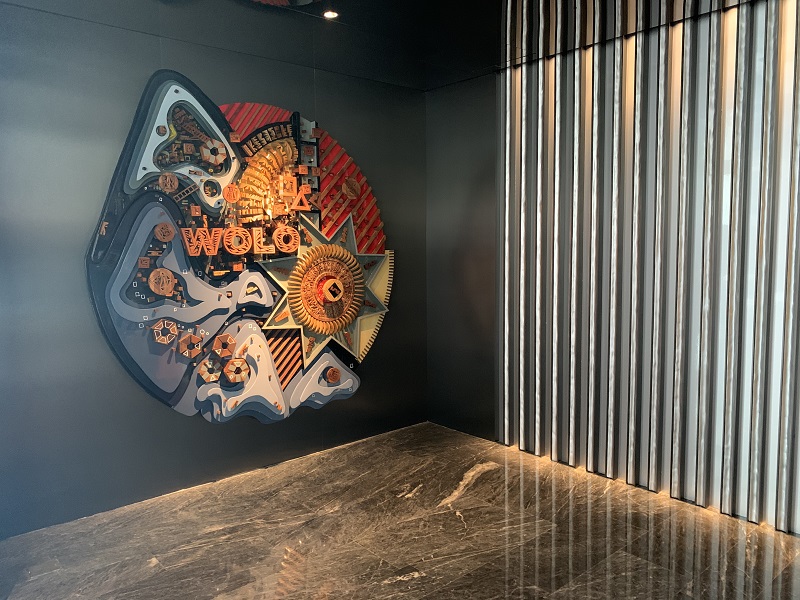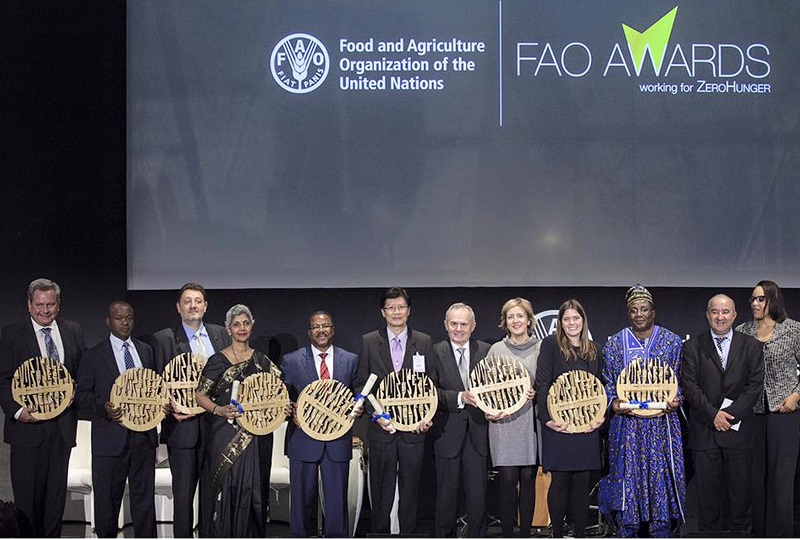
Anniketyni first kinetic piece for the Art of Time showcase in Pavilion KL — Time Machine — examines how time during the pandemic has changed for all of us (All photos: Anniketyni Madian)
Anniketyni Madian’s sculptural art is quite recognisable. Using her main medium, wood, she draws inspiration from her Sarawakian and Iban heritage to create complex pieces that hold meaning while being a treat for the eyes. With an incredible portfolio developed over a decade, Anniketyni has managed to achieve so much. The highlights of her career thus far include a solo exhibition called Bejampong in 2017 at Artcube Gallery, Kuala Lumpur; garnering accolades such as being among the Top 30 for the Sovereign Asian Art Prize (2016/17) and winning the Young Guns Art Award (2017); and participating in numerous residencies such as Rimbun Dahan in Selangor (2015), the World Youth Forum and Sculpture Symposium in Egypt (2018), and the Sculpture Symposium Arapan in Armenia (2019). “Every year is progress for me,” Anniketyni tells Options.
Anniketyni did not follow a straightforward road to becoming a full-time artist, though. During her school days in her hometown of Kuching, there was no arts stream option, and it was only when she moved to KL to sit for the Malaysian Certificate of Education (SPM) that she was able to explore her artistic talent. Unfortunately, she had to return to Kuching for the Malaysian Higher School Certificate (STPM) exam, and that forced her to focus on business studies instead. Anniketyni says her first application to Universiti Teknologi Mara (UiTM) was for civil engineering, but much to her family’s dismay, her heart was not in it.
“I did not want to waste my time doing something I did not like, and civil engineering takes three or four years to complete. That’s why I decided to pursue work instead. After Form Six, I worked as a draftsman with an engineering and architecture firm. I loved it. Learning about software such as AutoCAD, I found that I loved 3D things,” she says. After a year of working life, she reapplied to UiTM for the course she wanted and eventually graduated with a Bachelor of Fine Arts, with a major in sculpture.
Anniketyni professes that she is not a “painting person” but adores crafting three-dimensional items instead. It was the skill and technique behind creating sculptures that drew her attention. She took part in her first exhibition in 2008, when some of her seniors at university invited her to be part of a group show. Her initial work was assemblage, which is much like 3D collages. “I carry lessons from that first piece even until today. It was a journey and it was tough because you had to try to get the right material, [create] a good composition, a good size, everything,” she recalls.
img_0456.jpg

At UiTM, Anniketyni worked with an impressive range of media, including resin casting, clay and welding metal. “The most enjoyable material for me, however, is wood. Maybe it’s because I’m from nature, from Borneo, so it starts from there. Some materials have a negative aura when I start to work, sometimes I don’t get a good flow, which is very important when I work. It’s not easy to work with wood, but I enjoy what I do with it,” she explains.
Anniketyni’s father, a retired police officer turned construction technician, is also a source of knowledge when it comes to wood and woodworking. “I learnt a lot about originality [from him]. For example, we have a strong wood from Kuching called Belian. It’s a hard wood. I need to make sure that the wood I get is authentic and that’s why I need my father’s eyes to tell me whether what I want to buy is original,” she says.
One of Anniketyni’s main sources of inspiration is Pua Kumbu — a traditional ceremonial cloth of the Iban people that has intricate designs. “I want to preserve my culture, Borneo culture, in contemporary art. We don’t see this kind of element in sculptures. We do have Pua Kumbu in textiles in the fashion industry, but I don’t see it in art. It is also a privilege for me to [be able to use] this element … So, for me, Pua Kumbu is not just a fabric; it could be anything. In my works, there are a lot of patterns but I don’t really like to copy 100%. My content is Pua Kumbu, but the presentation is different,” she says.
About some of her pieces that she is most proud of, Anniketyni mentions her first commissioned project in 2015, which was for the UN. Because she was approached for the project via Facebook, she assumed it was a scam. A few emails later, Anniketyni was shortlisted with two other artists (from Japan and the US) to create the Recognition Sculpture for the Food and Agriculture Organisation (FAO) Awards 2015. “I sent over the proposal and the following day, [the contact] called me again and told me ‘You are the chosen one’,” she recalls.
fao_group.jpg

The deadline was short — just three weeks, including shipping time — and, as Anniketyni worked alone, the task proved to be an uphill battle. “I was working like a crazy, mad woman in the studio,” she quips. “I tried to maintain my fast work ethic during that time because I could not have any distractions. I managed to get the 10 pieces ready within a week and a half, and then I needed to sort out the boxes and shipment with all the paperwork.” It was only when the works arrived in Rome that the artist felt any relief. She has since crafted works for a slew of businesses, including One&Only Desaru Coast, Four Seasons and AFK Collection.
As Anniketyni is used to travelling for sculpture symposiums, attending residency programmes and maintaining a routine at her studio, the Movement Control Order came as a shock to her system. Apart from having to rework plans and carry out more discussions with clients, she also took time to sketch ideas for her artwork. Once restrictions were loosened, a rigid schedule ensued — after taking care of her daughter and dropping her off at the nursery, she would head for Muay Thai training (three times a week) and then to her studio to work from 9am to 6pm. It was during this time that her new seminal sculpture was brought to life.
Berandau Panjai Biar Mayuh Isiknya is an 8ft by 16ft piece that took Anniketyni four to five months to complete. While her Pua Kumbu elements are still pronounced, she explains that the work is about Sarawakian identity, family, marriage and traditional customs. This piece includes wood as well as epoxy resin, a material Anniketyni started to experiment with in 2008 but used in her works only from 2017. “You need to get that chemistry when you’re working with certain materials. So, that’s why I need to give myself time to understand, to go slowly with it and, only then, to combine it with wood,” she says.
What is unusual with this piece, other than its grand size, is the incorporation of the colour blue. Anyone familiar with Anniketyni’s works will notice that her colour palette is earthy, maintaining the colour of the wood or incorporating natural shades of green. “The specific colour that I used was sky blue for the resin. It’s about me. I got the feeling, the calmness with this colour. This seminal work was tricky, intricate and complicated, so I added the blue to be calm during the chaos. With the blue, I saw myself in the work,” she explains.
This year, Anniketyni crafted her first kinetic piece for the Art of Time showcase in Pavilion KL. Time Machine examines how time during the pandemic has changed for all of us, especially as it made it impossible to plan ahead. As she produced the moving elements of the sculpture, she realised something important about her journey. “I have not had a straight flow. I have this mixed education background, but it gives me more benefits now because I also enjoy working with mechanisms. So, all my previous engineering working techniques and experiences have been carried forward to today, and I am now working on kinetic elements,” she says.
Ever the busy bee, Anniketyni also spent time during lockdown planning her next solo exhibition, which is already taking shape, with the help of two assistants. “I want to highlight Sarawakian folklore. We hear and read about it in books, but it will be quite interesting when I present the visual element through my sculptures.”
She adds that each piece will tell a different story but maintain her abstract sensibility. Aiming for a solo exhibition in July 2022, she discloses that there will be 10 to 12 mixed media sculptures and one will include kinetic elements.
This article first appeared on Oct 25, 2021 in The Edge Malaysia.


